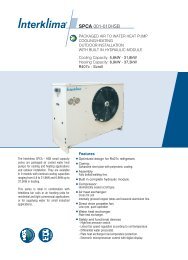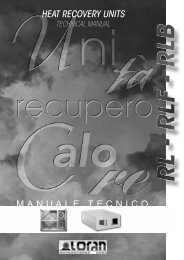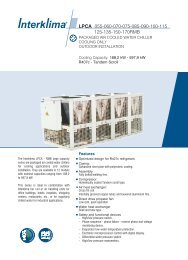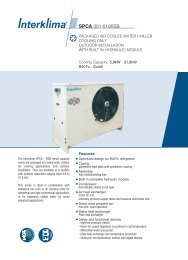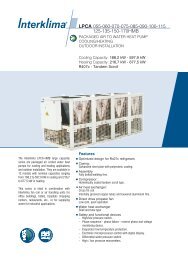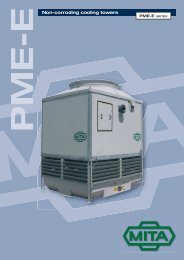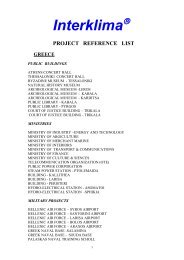central station air handling units: ctl
central station air handling units: ctl
central station air handling units: ctl
- No tags were found...
You also want an ePaper? Increase the reach of your titles
YUMPU automatically turns print PDFs into web optimized ePapers that Google loves.
AIR HANDLING UNITSTECHNICAL MANUAL1MANUALE TECNICO
INDICE21 Premessa2 Programma di selezione3 Certificazione4 Marcatura CE5 Legenda6 Selezione della grandezza7 Caratteristiche costruttive7.1 Struttura7.2 Basamento8 Componenti8.1 Batterie di scambio termico8.2 Batterie elettriche8.3 Filtri aria8.4 Recuperatori8.5 Separatori di gocce8.6 Vasche di raccolta condensa8.7 Serrande8.8 Umidificazioni8.9 Silenziatori8.10 Ventilatori8.11 Motori8.12 Supporti gruppo ventilante8.13 Trasmissioni8.14 Giunti antivibranti8.15 Sezione ventilante9 Dimensioni9.1 Sezioni ventilante9.2 Serrande - Camere di miscela9.3 Filtri a bassa efficienza9.4 Filtri ad alta efficienza9.5 Batterie9.6 Separatore - Umidificazioni9.7 Umidificatori a lavatore9.8 Recuperatori di calore9.9 Multizone9.10 Silenziatori10 Selezione e richiesta d’offerta10.1 Modulo tecnico <strong>central</strong>i10.2 Disegno schematico per orientamento unità11 Diagramma psicrometrico
CONTENTS1 Introduction2 Selection software program3 Certification4 CE marking5 Legend6 Choosing the size7 Technical features7.1 The frame7.2 Base8 Component8.1 Heat exchange coils8.2 Electric coils8.3 Air filters8.4 Heat recovery <strong>units</strong>8.5 Droplet separators8.6 Condensating collection tanks8.7 Dampers8.8 Humidifiers8.9 Silencers8.10 Fans8.11 Electric motors8.12 Fan group supports8.13 Transmissions8.14 Isolation couplings8.15 Fan section9 Dimensions9.1 Fan section9.2 Dampers - Mixing chamber9.3 Low efficiency filters9.4 High efficiency filters9.5 Coils9.6 Separator - Humidifier9.7 Washer humidifiers9.8 Heat recovery <strong>units</strong>9.9 Multi-zones9.10 Silencers10 Selection and offer enquiry10.1 Central <strong>station</strong> technical schedule10.2 Schematic drawing for unit sides11 Psychrometric chart➥ ➥3
4CENTRALI TRATTAMENTOARIA: CTLCENTRAL STATIONAIR HANDLING UNITS: CTL
1 PREMESSALa premessa fondamentale alla consultazione di questo catalogo è che quanto riportato,rappresentaun punto di riferimento non vincolante. La prerogativa è infatti quella dipresentare la nostra gamma di Centrali di Trattamento Aria illustrandone le caratteristicheprincipali, garantendo al tempo stesso realizzazioni necessariamente particolari edesclusive, viste le difficoltà che troppo spesso ci si trova a dover affrontare in cantiere.Siamo per questo a Vostra completa disposizione, per aiutarVi a risolvere ogni problemalegato alla realizzazione di Centrali di Trattamento Aria.Le Centrali di Trattamento Aria tipo CTL rappresentano un importante contributo almiglioramento del nostro ambiente di vita. Frutto della professionalità e della pluriennaleesperienza LORAN, costituiscono un punto di riferimento.La qualità delle costruzioni e dei componenti impiegati sono garanzia di affidabilità, funzionalitàed efficienza.Progettate per funzionare a bassa, media e alta pressione, le Centrali CTL sono costruitecon un sistema modulare che prevede 18 grandezze in grado di soddisfare una vastagamma di portate.Le unità di Trattamento Aria LORAN,in esecuzione normale,non sono adatte per il funzionamentoin ambienti con atmosfera esplosiva.51 INTRODUCTIONWhen consulting this catalogue, it is essential to remember that wath is shownis a reference guide to our production and that therefore some articles may differ.Our aimin fact is to present our range of <strong>central</strong> <strong>station</strong> <strong>air</strong> <strong>handling</strong> <strong>units</strong> by illustrating their maincharacteristics. At the same time we guarantee constructing special and exclusivesystems which are necessary given the difficulties we too often have to face on site. Forthis reason we are always on hand to help you solve all the problems tied to creating<strong>central</strong> <strong>station</strong> <strong>air</strong> <strong>handling</strong> <strong>units</strong>.The CTL types of Central <strong>station</strong> Air Handling Units have been designed with the specificscope of improving our environment. they are based on LORAN’s high professionalskill and long experience and represent a benchmark. The quality of the constructionwork and the components employed guarantee reliability,functionality and efficiency.TheLORAN CTL range,designed to operate on low,medium end high pressures,is also modularand is available in 18 sizes to satisfy a vast range of <strong>air</strong> volumes.Standard LORAN <strong>air</strong> <strong>handling</strong> <strong>units</strong> are not suitable for operating in explosive environments.➥
2 PROGRAMMA DI SELEZIONECTLORAN è il programma di selezione realizzato per proporre, con estrema semplicità,un quadro funzionale, costruttivo ed economico della <strong>central</strong>e richiesta. Uno strumentopratico e completo, indispensabile per il dimensionamento delle Centrali diTrattamento Aria LORAN.Per l’estrema semplicità di utilizzo, per la completezza dei dati e per la quantità disoluzioni proposte è apprezzato da numerosi “termotecnici”, ai quali viene fornito semplicementesu richiesta.Personale specializzato LORAN è inoltre a disposizione per chiarimenti all’utilizzo diquesto software.2 SELECTION SOFTWARE PROGRAMThe “CTLoran” selection software program is available to define the functional, constructiveand economical characteristics of the <strong>central</strong> <strong>station</strong> required, with extreme ease.This is a practical and complete tool, essential for sizing <strong>central</strong> <strong>station</strong> <strong>air</strong> <strong>handling</strong> <strong>units</strong>.Numerous thermo-technical studios have appreciated this software - made availableto them on request - because of its simplicity in use, the completeness of the data andthe quality of the solution offered.Specialist Loran staff are also available for any help or training in using this software.6
3 CERTIFICAZIONELORAN opera in regime di Qualità certificato secondo la Norma UNI EN ISO 9001.È il risultato di una valida politica aziendale, impostata sulla ricerca costante dello sviluppodel prodotto e del miglioramento del servizio reso, una garanzia per il Cliente chetrova in LORAN un valido interlocutore. Un sistema efficiente, costantemente in crescita,gestito con personale competente e dinamico che permette di controllare il prodotto inogni fase della lavorazione e con la massima scrupolosità.3 CERTIFICATIONThe Quality System at LORAN is certified according to the UNI EN ISO 9001 Standard.This is the result of a worthy company policy, based on constant research into productdevelopment and improving the service provided. All this guarantees that customers areguaranteed to find a valid partner in LORAN. Here, a constantly growing, efficient system,managed by competent and dynamic personnel keeps the product under control - in allworking phases - with maximum care.➥ ➥7
4 MARCATURA CETutte le Unità di Trattamento Aria LORAN sono costruite nel rispetto delle Direttive CEE89/392, 91/368, 93/44, 93/68, 73/23 alle stesse applicabili e sono quindi conformi ai“requisiti essenziali di sicurezza e di tutela della salute” prescritti dalle Direttive stesse. Laprogettazione viene sviluppata nel rispetto di tali norme e,a tal fine,le macchine sono dotate,di serie, di dispositivi di prevenzione e sicurezza idonei a soddisfare i requisiti richiesti:• reti antinfortunistiche di protezione sugli organi in movimento• microinterruttori di sicurezza• lampade per l’illuminazione interna della macchina• maniglie apribili anche dall’interno della macchina• spigoli arrotondati e assenza di parti taglientiCartelli adesivi, ben visibili per dimensione e colore, vengono applicati sulla cassonaturaesterna della macchina a indicare pericoli dovuti ad organi in movimento e a presenzadi corrente elettrica.84 CE MARKINGAll LORAN <strong>air</strong> <strong>handling</strong> <strong>units</strong> are constructed in compliance with the applicable EECDirectives 89/392, 91/368, 93/44, 93/68, 73/23: these <strong>units</strong> therefore conform to “theessential safety and health protection requirements” established by these Directives.The design work is develped respecting these standards and to this end the machinesare equipped with a series of prevention and safety features suitable for satisfying theobligatory requirements:• accident prevention protection grills over moving parts;• safety micro-switches;• lights for illuminating the inside of the machines;• handles that open also from inside the machine;• rounded edges and no parts that cut.Adhesive signs - clearly visible because of their colour and size are applied to theexternal casings of the machine indicating possible dangers from moving parts and theelectric current present.
5 LEGENDA LEGENDQ portata aria<strong>air</strong> volume (<strong>air</strong> flow) m 3 /hS superficie frontale delle batterie di scambio termicofront area, heat exchange coils m 2V velocità frontale dell’aria all’interno dell’unità<strong>air</strong> face velocity inside unitm/secE efficienza filtrantefilter efficiency %Ue efficienza della sezione di umidificazionehumidifyng section efficiency %P potenza termica totale resa dalle batterie di scambio termico (potenza totale)heat exchange coil total thermal capacity (total capacity)kcal/hP s potenza termica sensibile (potenza sensibile)sensible thermal capacity (sensible capacity)kcal/hR c rapporto fra potenza sensibile e potenza totalethermal capacity ratio, sensible/totalCA coefficiente della perdita di carico lato aria per passo alette batterie<strong>air</strong> pressure drop coefficient per coil fin spacingCH coefficiente della perdita di carico lato aria per batteria di raffreddamento<strong>air</strong> pressure drop coefficient, cooling coilsCP coefficiente di resa per diversi passi di aletteperformance coefficient per fin spacingTbs 1 temperatura a bulbo secco aria entranteentering <strong>air</strong> dry bulb (d.b.) temperature °CTbu 1 temperatura a bulbo umido aria entranteentering <strong>air</strong> wet bulb (w.b.) temperature °CUR 1 umidità relativa aria entranteentering <strong>air</strong> relative humidity %Tbs 2 temperatura a bulbo secco aria uscenteleaving <strong>air</strong> dry bulb (d.b.) temperature °CTbu 2 temperatura a bulbo umido aria uscenteleaving <strong>air</strong> wety bulb (w.b.) temperature °CUR 2 umidità relativa aria uscenteleaving <strong>air</strong> relative humidity %te temperatura acqua entranteinlet water temperature °Ctu temperatura acqua uscenteoutlet water temperature °C∆p perdite di carico circuito acquawater pressure dropkPat temperatura di evaporazione del fluido frigorifero o del vaporerefrigerant gas evaporating temperature, or steam temperature °CR numero dei ranghi della batteriacoil number of rowsHs pressione statica utile dell’aria<strong>air</strong> available static pressure (external static pressure)PaH 1,2,... perdita di carico lato aria dei singoli componenti della <strong>central</strong>e<strong>air</strong> pressure drop of different unit sectionsPaHp perdita di carico totale lato aria<strong>air</strong> total pressure dropPaHt pressione statica totale dell’aria<strong>air</strong> total static pressurePan velocità di rotazione del ventilatorefan speedrpmNa potenza assorbita all’albero del ventilatorefan shaft brake power inputkWNi potenza motore installataelectric motor nominal powerkWLw(A) potenza sonora emessa dal ventilatorefan sound power leveldB(A)➥ ➥9
6 SELEZIONE DELLA GRANDEZZAIn funzione della portata d’aria richiesta dall’impianto e della velocità dell’aria all’internodella <strong>central</strong>e, viene individuata la grandezza dell’unità.Il diagramma consente una rapida selezione e, a tal fine, è necessario tener presenteche elevate velocità dell’aria consentono macchine di piccole dimensioni e costoinferiore, ma portano inevitabilmente ad un livello di emissione acustica più elevato, davalutare ogni volta in funzione dello specifico impiego.6 CHOOSING THE SIZESelection of the unit size can be obtained by using the selection diagram below.10Unit size is given as a function of the requested <strong>air</strong> volume at a chosen <strong>air</strong> velocityacross the <strong>central</strong> <strong>station</strong>. This diagram allows fast and easy preliminary size section,however choice of high <strong>air</strong> velocities, though allowing lower unit overall dimensions andcost, will result in <strong>central</strong> <strong>station</strong>s with higher sound levels, which must be considerationaccording to the equipment applications.The following table shows <strong>air</strong> velocity limit which should be considered when chosingthe unit <strong>air</strong> velocity in the most usual applications.



